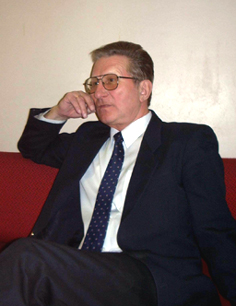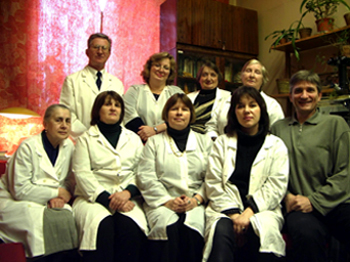| Laboratory of Cancer Growth Cytology |
Vadim Aleksandrovitch IVANOVD.Sci., Ph.D.Теl.: +7 (812) 297-42-34
The Laboratory was founded in the year of 1977. The principal goals of the Laboratory work are to disclose biochemical and immune mechanisms of a carcinogenesis and to reveal conditions for cancer prevention. The main study objects are experimantal malignant tumors induced in animals by chemical carcinogens. The methods employed are the contemporary techniques used in experimental oncology, molecular biology, preparative and analitical biochemistry, cytology, immunology, mass-spectrometry, etc. The priority findings obtained in our researches bring a new light to one of the crusial processes of altered cytodifferentiation in carcinogenesis - the antigenic divergence regarding to appearance of tumor-associated heteroorganic antigens. The studies have been supported by the Russian Foundation for Basic Research, Saint-Petersburg Scientific Center of the Russian Academy of Sciences and Saint-Petersburg Society for Nature Sciences. |

|

|
Laboratory Staff:
N.P. Teryukova, PhD, senior research scientist
|
|
Main Research Directions: 1) Studies of the changes induced by chemical carcinogens in a cell differentiation.
2) Investigation and detailed characterisation of the antigenic divergence phenomena - an obligatory process of cytodifferentiation abnormalities occurring at carcinogenesis.
3) Investigation of mechanisms underlying the immune control of cytodifferentiation and a natural antitumor resistance. An important role in these processes belongs to natural killer cells. Natural killers are capable to recognise auto-antigens and, due to this feature, to control normal antigen composition in a definitive tussue cells as well as cell differentiation. Several trials of our Laboratory have been focused on specific adhesive proteins appearing on a cell surface in hepatocellular tumors, some of which have been identified already. According to our data, these proteins can play a sufficient role in recognition of transformed cells by the immune system and by natural killers, in particular. Other studies deal with changes in the functioning of a control system for the autologous cell differentiation, proliferation, apoptosis, and resistance to genotoxic factors. We examine structural and functional parameters of immune cells (various types of lymphocytes) during immune response. We study a nuclear excision repair system in lymphocytes exposed to DNA-damaging radiation. We evaluate a natural killer cell activity after exposure of NK-cells to certain immunosuppressors and immunomodulators. Our results have demonstrated for the first time the characteristic changes of both phenotype and cytokine profiles in peripheral human lymphocytes during immune response following the exposures of the body to electromagnetic radiation of optical range. We also received the new data about a nuclear excision repair of DNA lesions in unstimulated lymphocytes (a predominant type of peripheral lymphocytes) which appears to be retarded due to the excision phase prolongation. |
|
Most important publications: V.A. Ivanov, V.Ja. Fel. On some similarity between membrane antigens of the cell of Zajdela hepatoma and liver of rats subjected to a single 4-dimethylaminoazobenzene injection. Neoplasma. 1980. 27 (6): 745-750. V.Ja. Fel., N.V. Zacharova, V.A. Ivanov, N.D. Medvedeva, I.A. Khodosova. Expression of -fetoprotein, aldolase fetal isozyme A and heteroorganic antigens in rat liver cell after a single hepatocarcinogen treatment. Onco-developmental Biol. and Medicine. 1981. 2 (3): 197-201. V.A. Ivanov, V.P. Kushner. 1994. Disdifferentiation of tumor cells and heteroorganic antigens. Proceedings of the XVI International Cancer Congress. P.536-537. V.A. Ivanov, V.Ja. Fel. 1995. A comparative investigation of the synthesis of membrane heterorganic antigens of kidney origin in tissue sections and in isolated cells after a single carcinogenic injection of rats. Tsitologiya. 37 (3): 227-231. N.P. Teryukova, I.I. Tyuryaeva, A.B. Grandilevskaya, V.A. Ivanov. 1997. Revealing the membrane tumor-associated antigens of hepatoma Zajdela on the surface of rat cultuted cells. Tsitologiya. 39 (7): 577-581. V.P. Kushner, G.I. Blinova, A.B. Grandilevskaya, A.A. Klimova, V.A. Ivanov. 1997. Stimulation of cell proliferation by chromosomal nonhistone proteins pp23. Experimental oncology. 19 (4): 300 - 306. A.B. Grandilevskaya, I.G. Grusdeva, V.A. Ivanov. 2001. Comparative study of nonhistone chromosomal pp23 protein in normal and tumor rat cells. Experimental oncology. 23 (2): 104 -108. S.I. Chernysh, S.I. Kim, G.P Becker, N.A. Filatova, V.A. Pleskach, V.B. Anikin, V.G. Platonov, Ph. Bulet. 2002. Antiviral and antitumor peptides from insects. PNAS. 99 (20): 12628 - 12632. S.I. Chernysh, N.A. Filatova, N.S. Chernysh, A. P. Nesin. 2004. Cytotoxic activity of the blowfly Calliphora vicina hemocytes. Journal of Insect Phisiology. 50: 777 - 781. S.A. Snopov, F. R. de Gruijl, L. Roza, J.C. van der Leun. 2004. Immunochemical study of DNA modifications in the nuclei of UV-damaged lymphocytes. Photochemical and Photobilogical Sciences. 3(1): 85-90. I.I. Tyuryaeva, O.A. Mirgorodskaya, O.A. Cherepanova, E.P. Podolskaya, A.V. Novikov, M.A. Hodorkovski, V.A. Ivanov. 2005. Revelation and identification of laminin in the structure of plasma membrane of Zajdela ascitic hepatoma cells. Tsitologiya. 47 (2): 150-162. I.I. Tyuryaeva, O.A. Mirgorodskaya, O.A. Cherepanova, E.P. Podolskaya, M.V. Serebryakova, V.A. Ivanov. 2005. Interaction of laminin with plasma membrane components of Zajdela ascitic hepatoma cells. Tsitologiya. 47 (12): 1039-1047. N.P. Teryukova, P.A. Ivashkina, O.A. Mirgorodskaya, V.A. Ivanov. 2005. Revelation and identification of tumor associated heteroorganic antigens among chromatine nonhistone proteins of Zajdela hepatoma. Tsitologiya. 47 (12): 1048-1054. S.A. Snopov, S.M. Kharit, M. Norval, V.V. Ivanova. 2005. Circulating leukocyte and cytokine responses to measles and poliovirus vaccination in children after ultraviolet radiation exposures. The Archives of Virology. 150 (9): 1729-1743. I.I. Tyuryaeva. 2008. Tumor antigens. Tsitologiya. 50 (3): 189-209. N.A. Filatova, I.I. Tyuryaeva, V.A. Ivanov. 2008. Recognition and lysis by Natural killers of tumors cells with participation of laminin. Cell and Tissue Biology. 2 (1): 38- 44. N.P. Teryukova, G.I. Blinova, Yu.M. Rozanov, V.A. Ivanov. 2008. Study of surface heteroorganic antigens of rat hepatoma cells participating in the cell proliferation process. Cell and Tissue Biology. 2(3):246-252. N.A. Knyazev, K.A. Samoilova, N.A. Filatova, A.A. Galactionova. 2009. Effect of polychromatic visible light on proliferation of tumor cells under conditions in vitro and in vivo after implantation to experimental animals. American institute of physics (AIP) Conference Proceedings. Ed. L. Longo, Melville, New York, 1142: 79-86. S.V. Shabelnikov, O.A. Bystrova, V.A. Ivanov, B.A. Margulis, M. Martynova. 2009. Atrial granular cells of the snail Achatina fulica release proteins into hemolymph after stimulation of the heart nerve. J. Exp. Biol. 212: 3211-3220. |
Structure Home |